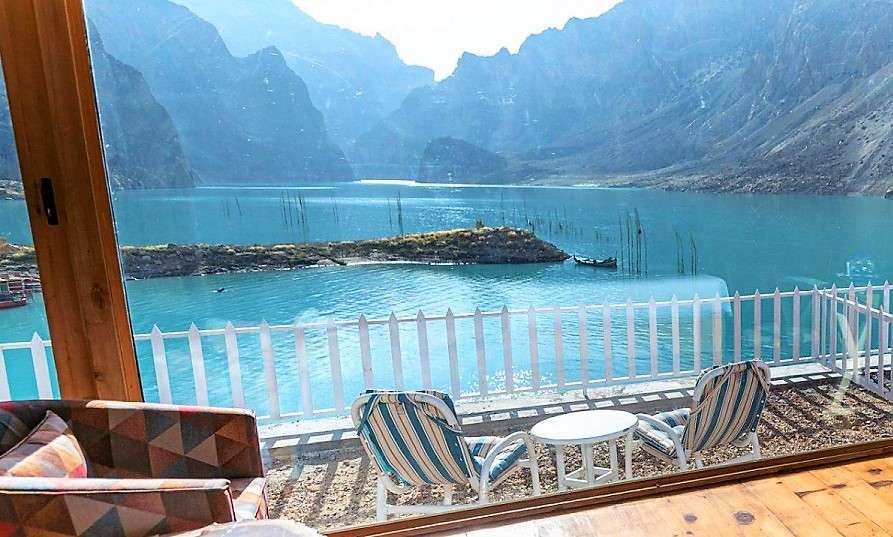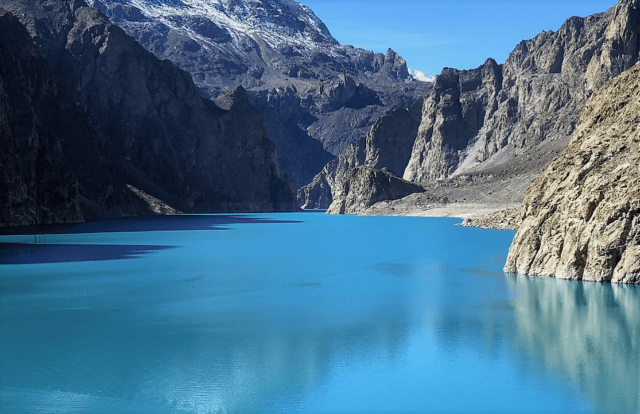A lake called Attabad Lake may be found in Gilgit-Baltistan, Pakistan, in the Hunza Valley’s Gojal region.
Attabad Lake is located around 30 minutes to the east of Karimabad, the administrative center of the Hunza District in Pakistan’s Gilgit-Baltistan province.
Attabad Lake has a depth of 357.6 feet. Its altitude of 8396 feet makes it one of Pakistan’s deepest lakes.
Attabad Lake, one of Pakistan’s most picturesque lakes and a breathtaking outcome of a natural calamity, draws hundreds of tourists each year.
The Lake, which is in the village of Attabad, was formed as a result of a significant natural disaster in 2010. As a result of a significant landslide that occurred in Attabad in January 2010, it was formed.
Read Also
Neelam Valley: A Picturesque Beauty
Attabad Lake’s serene surroundings and deep blue water give the impression that you are in a poet’s paradise, but the reality was far less lovely.
1. Natural Disaster of 2010
Twenty people were killed in the landslide, which also prevented the Hunza River from flowing for five months.
The 6,000 residents in towns upstream were displaced by the lake flooding, which also shut down 25,000 kilometers of land travel and covered more than 12 miles of the Karakoram Highway.
By the first week of June 2010, the lake had grown to be 13 miles long and more than 330 feet deep. At that point, it started to overflow the landslide dam, totally drowning lower Shishkat and partially flooding Gulmit. The Gojal subdivision contains around 170 homes and 120 businesses, making it the area with the most inundated structures.
A disparity in the outflow and input of the new lake led to a spike in water levels on June 18, 2010, which persisted. Due to the Karakoram Highway being blocked, there were also food and other supply difficulties for the locals.
The supply of food, medication, and other items was interrupted while terrible weather persisted because no mode of transportation, including helicopter service to Hunza, could be restarted.
A sit-in was organized by those who had been affected by the landslide and lake expansion to protest the lack of government action and compensation for them. Five towns north of the barrier were flooded as a result of the Hunza River being dammed.
Read Also
Baghsar Fort – Land of Gardens and Water
Ayeenabad, one of the villages, was completely drowned. Another community, Shishkat, had significant areas that were also submerged. The settlement of Gulmit, which acts as the administrative center for Gojal Valley, was also submerged to a depth of almost 40%.
2. Formation of Lake
Despite the stunning beauty of Attabad Lake itself, it has a horrible past. Twenty people tragically died as a result of the landslide that produced this lovely tourist destination, and the Hunza River’s water flow was blocked for five months.
The lake was created by a landslide that happened 9 kilometers upstream east of Karimabad on January 4, 2010, in the Attabad village in Gilgit-Hunza Baltistan’s Valley.
The rising lake caused significant areas of land in the Gojal villages of Hussaini and Ghulkin to also get inundated.
The lake had an impact on the entire population of up to 25,000 people of central Hunza and the Gojal valley, due to challenges with accessing business markets via roads, as well as the loss of land, homes, and agricultural goods.
Former Prime ministers Yousuf Raza Gillani, Nawaz Sharif, and Punjab Chief Minister Shahbaz Sharif all paid a visit to Attabad Lake. The Punjabi government would provide Rs 100 million in help to the sufferers, while Rs 0.5 million will go to the loved ones of those who perished in the landslide.
Read Also
Hingol National Park – A trademark of Balochistan
Although some officials thought that a big flood scenario was less likely once the river started pouring over the landslide dam during the first week of June 2010, areas downstream from the lake remained on alert. 195 aid camps have received a large influx of evacuees.
Attabad Lake has now supported local residents’ livelihoods for eleven years. The same lake that completely cut off the residents of Attabad hamlet is now a source of revenue for them.
Since the lake’s formation, it has been used as a location for tourist attractions. The lake’s distinctive color has created a strong demand among people to see it, making it a popular tourist destination. The bare treetops in the lake’s middle provide a clue to how produced this natural wonder.
The 25-kilometer-long lake is transformed into the fire by the setting sun’s combination of a deep shade of blue and a deep orange hue, which also penetrates the imposing mountains that surround it. When the sun goes down, the beauty doesn’t end since the moonlight adds a whole new level of captivating grace to the scene.
3. Tourist Destination
When melt water from the nearby mountains dumps glacial silt into the lake in the spring and early summer, the lake’s frigid waters turn an amazing turquoise colour.
The lake frequently freezes over in the winter. The greatest time to visit Attabad Lake and spend time there is during the summer. Enjoy walking on Attabad Lake, one of Pakistan’s most well-known frozen lakes, if you like taking chances.
In the summer, breathtaking views are provided by the teal waters of Attabad Lake and the beautiful Karakoram Mountains. In the winter, Attabad Lake gradually turns into a solid block of ice. People like to stroll along the slick, frozen Attabad Lake when it freezes.

When the lake is free of ice, the majority of visitors come to take in this breathtaking landscape. On and around the lake, people engage in boating, jet skiing, and fishing as forms of recreation.
Additionally, a few campsites and an increasing number of hotels and guesthouses have appeared all around the lake as a result of the increase in tourism.
Probably many of the residents who were impacted by the landslide have profited from the increase in tourists. Access is also improved now that the roadway has been renovated with new tunnels.
The thought that a once-vibrant community can be found 300 meters below you is surprising, though, if you take a boat out onto the quiet surface of Attabad Lake.
Attabad Lake is currently one of Pakistan’s most popular tourist destinations. The Pakistani government, however, is preparing to construct a dam around the lake as a result of the growing water level.







